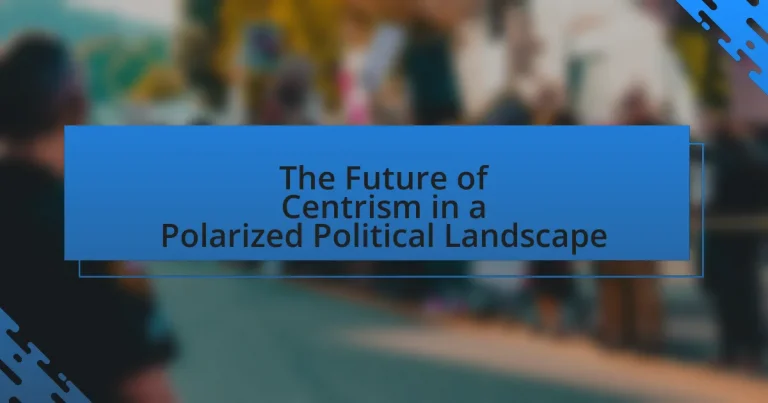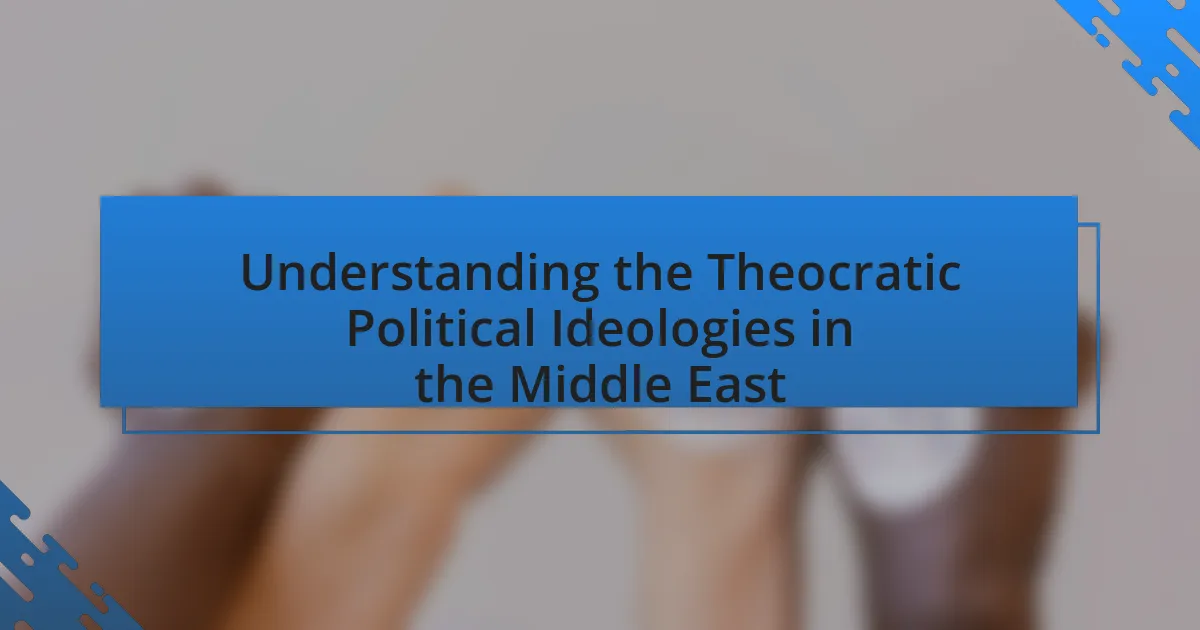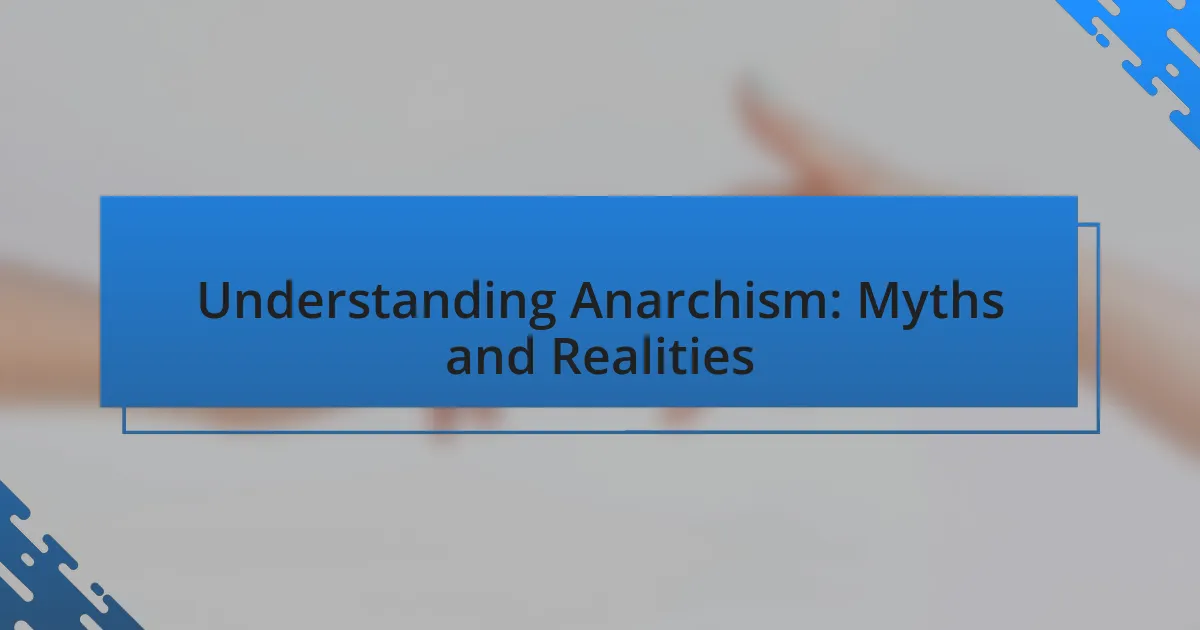Centrism, defined as a political ideology that seeks a middle ground between extreme left and right positions, plays a significant role in today’s polarized political landscape. This article explores the core principles of Centrism, its differences from other ideologies, and its relevance in contemporary governance. It examines the challenges Centrism faces due to increasing polarization, the impact of extreme political views, and the role of media in shaping perceptions. Additionally, the article discusses strategies for Centrists to navigate polarization, engage with younger voters, and build coalitions across party lines, while considering the influence of emerging political movements and demographic shifts on the future of Centrism.
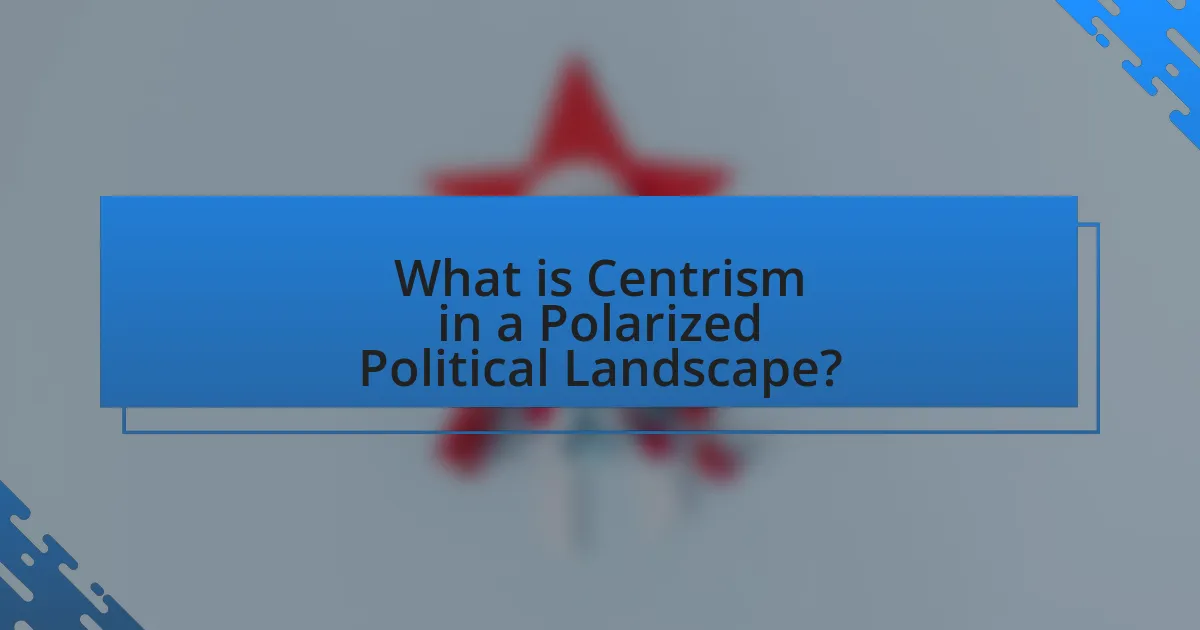
What is Centrism in a Polarized Political Landscape?
Centrism in a polarized political landscape refers to a political ideology that seeks a middle ground between extreme left and right positions. Centrists advocate for balanced policies that incorporate elements from both sides, aiming to foster compromise and cooperation. In the context of increasing political division, centrism often emphasizes pragmatic solutions over ideological purity, appealing to a broader electorate. Research indicates that in highly polarized environments, centrists can play a crucial role in bridging divides, as evidenced by electoral trends showing that moderate candidates often attract support from diverse voter bases, thereby enhancing political stability and governance effectiveness.
How does Centrism differ from other political ideologies?
Centrism differs from other political ideologies by advocating for a balanced approach that seeks to integrate ideas from both the left and right, rather than adhering strictly to one side. Centrists prioritize pragmatic solutions over ideological purity, often focusing on compromise and consensus-building to address societal issues. This approach contrasts with more extreme ideologies, such as socialism or conservatism, which typically promote specific, often polarized, agendas. For example, in the United States, centrists may support a mixed economy that incorporates elements of both capitalism and social welfare, reflecting a middle-ground stance that aims to appeal to a broader electorate.
What are the core principles of Centrism?
The core principles of Centrism include moderation, pragmatism, and a balanced approach to policy-making. Centrists advocate for solutions that draw from both liberal and conservative ideologies, aiming to find common ground and compromise. This approach is rooted in the belief that extreme positions can lead to polarization and ineffective governance. Historical examples, such as the bipartisan efforts in the U.S. during the 1990s, demonstrate how Centrism can facilitate cooperation across party lines, resulting in significant legislative achievements like welfare reform and budget balancing.
How does Centrism address the challenges of polarization?
Centrism addresses the challenges of polarization by promoting dialogue and compromise between opposing political factions. Centrists advocate for policies that incorporate diverse viewpoints, which helps to bridge the divide between extreme positions. For instance, research indicates that centrist policies often lead to bipartisan support, as seen in various legislative efforts that have garnered approval from both sides of the aisle, such as the 2018 First Step Act aimed at criminal justice reform. This approach not only fosters cooperation but also encourages a more inclusive political discourse, ultimately reducing the intensity of polarization.
Why is Centrism relevant in today’s political climate?
Centrism is relevant in today’s political climate because it offers a pragmatic approach to governance that seeks to bridge the divide between polarized political factions. In an era marked by extreme partisanship, centrism promotes dialogue and compromise, which can lead to more effective policymaking. For instance, a 2020 Pew Research Center study found that 55% of Americans expressed frustration with the political extremes, indicating a desire for moderate solutions. This growing sentiment underscores the importance of centrist policies that can address the concerns of a diverse electorate while fostering stability and cooperation in governance.
What historical events have influenced the rise of Centrism?
The rise of Centrism has been influenced by several historical events, notably the aftermath of World War II, the Cold War, and the economic crises of the late 20th century. After World War II, many nations sought stability and moderation in governance, leading to the establishment of centrist parties that aimed to balance competing ideologies. During the Cold War, the ideological battle between capitalism and communism prompted many voters to gravitate towards centrist positions that advocated for compromise and bipartisanship to avoid extremism. Additionally, economic crises, such as the 2008 financial meltdown, highlighted the failures of both left and right policies, prompting a search for centrist solutions that could address economic inequality while promoting growth. These events collectively fostered an environment where Centrism could thrive as a pragmatic alternative to polarized political extremes.
How do current political trends impact the viability of Centrism?
Current political trends significantly diminish the viability of Centrism by fostering increased polarization and ideological extremism. As political parties and movements gravitate towards more extreme positions, the middle ground represented by Centrism becomes less appealing to voters seeking clear, decisive stances. For instance, recent electoral data from the United States shows that in the 2020 presidential election, candidates with more extreme views garnered greater support, indicating a shift away from moderate platforms. Additionally, surveys reveal that a growing number of voters identify with either the far-left or far-right, further marginalizing centrist perspectives. This trend suggests that as polarization intensifies, Centrism struggles to maintain relevance in a landscape increasingly defined by binary choices.

What challenges does Centrism face in a polarized environment?
Centrism faces significant challenges in a polarized environment, primarily due to the increasing ideological divide between political factions. This polarization often leads to the marginalization of centrist viewpoints, as extreme positions dominate public discourse and political representation. For instance, research from the Pew Research Center indicates that political parties in the United States have become more ideologically distinct, with a growing number of voters identifying strictly with either liberal or conservative ideologies, leaving centrists without a strong electoral base. Additionally, centrists struggle to gain traction in legislative processes, as partisan gridlock often prioritizes party loyalty over compromise, further diminishing the influence of moderate policies.
How do extreme political views affect Centrism’s appeal?
Extreme political views diminish Centrism’s appeal by creating a polarized environment where moderate positions are often overlooked. In a landscape dominated by radical ideologies, individuals may perceive Centrism as indecisive or lacking conviction, leading to a preference for more extreme alternatives that promise clear solutions. Research indicates that as political polarization increases, the number of voters identifying as moderate decreases, with a 2020 Pew Research Center study showing that 36% of Americans identified as moderate, down from 49% in 2000. This trend suggests that extreme views not only overshadow moderate perspectives but also contribute to a shrinking base for Centrism, making it less attractive to voters seeking decisive action.
What role does media play in shaping perceptions of Centrism?
Media plays a crucial role in shaping perceptions of Centrism by influencing public discourse and framing political narratives. Through selective coverage, media outlets can highlight centrist viewpoints, thereby normalizing them within the broader political landscape. For instance, studies have shown that balanced reporting on centrist policies can lead to increased public support, as seen in the 2016 U.S. presidential election where centrist candidates received more favorable media attention compared to their more extreme counterparts. This media framing can either reinforce or challenge existing biases, ultimately affecting how Centrism is perceived by the electorate.
How do political parties respond to the presence of Centrism?
Political parties respond to the presence of Centrism by adjusting their platforms and strategies to appeal to moderate voters. This adaptation often includes adopting centrist policies or rhetoric to attract a broader electorate, especially in polarized environments where extreme positions may alienate potential supporters. For instance, in the United States, both major parties have occasionally shifted their stances on issues like healthcare and taxation to capture the centrist vote, as evidenced by the Democratic Party’s embrace of moderate healthcare reforms during the 2020 election cycle. This strategic response highlights the influence of Centrism in shaping party dynamics and electoral outcomes.
What strategies can Centrists employ to navigate polarization?
Centrists can employ dialogue facilitation as a primary strategy to navigate polarization. By creating platforms for open discussions between opposing viewpoints, Centrists can foster understanding and reduce hostility. Research indicates that structured dialogues can lead to increased empathy and decreased polarization, as evidenced by programs like the National Institute for Civil Discourse, which promotes constructive conversations across political divides. Additionally, Centrists can advocate for policy solutions that appeal to a broad spectrum of constituents, thereby demonstrating that compromise is possible and beneficial. This approach is supported by studies showing that bipartisan initiatives often receive greater public support, highlighting the effectiveness of collaborative governance in a polarized environment.
How can Centrists build coalitions across party lines?
Centrists can build coalitions across party lines by focusing on shared values and common goals that transcend partisan divides. By identifying issues such as economic stability, healthcare access, and education reform, Centrists can unite individuals from different political backgrounds who prioritize these concerns. Historical examples, such as the bipartisan support for the Affordable Care Act in its early stages, demonstrate that collaboration on specific policy areas can lead to successful coalitions. Additionally, engaging in open dialogue and fostering relationships with members of opposing parties can create a foundation for trust and cooperation, further enhancing the potential for cross-party alliances.
What communication tactics can enhance the Centrism message?
Effective communication tactics that can enhance the Centrism message include emphasizing common ground, utilizing inclusive language, and leveraging storytelling. Emphasizing common ground allows Centrists to connect with diverse audiences by highlighting shared values and goals, which can foster collaboration and reduce polarization. Utilizing inclusive language ensures that the message resonates with a broader demographic, making it more relatable and accessible. Leveraging storytelling can humanize complex issues, making them more engaging and memorable, thereby increasing the likelihood of audience retention and support. These tactics are supported by research indicating that messages framed around shared interests and narratives are more effective in bridging divides and fostering understanding in a polarized political landscape.
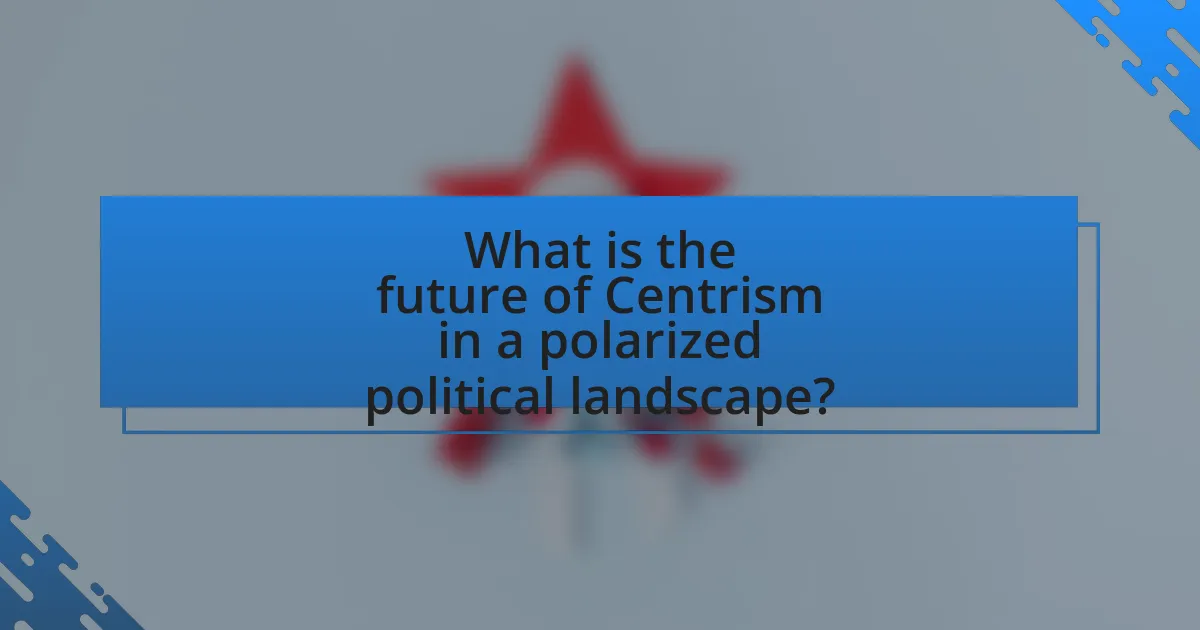
What is the future of Centrism in a polarized political landscape?
The future of Centrism in a polarized political landscape appears challenging yet potentially viable. Centrism, characterized by moderate political positions, may struggle to gain traction as extreme partisan views dominate public discourse. However, historical trends indicate that during periods of heightened polarization, there is often a counter-movement towards moderation, as seen in various electoral cycles where centrist candidates have gained support by appealing to disenchanted voters from both sides. For instance, the 2020 U.S. elections demonstrated a significant number of voters prioritizing bipartisanship and compromise, suggesting a demand for centrist policies. Thus, while the immediate environment may seem unfavorable, the cyclical nature of political sentiment could allow Centrism to re-emerge as a compelling alternative in the future.
How might emerging political movements influence Centrism?
Emerging political movements may significantly influence Centrism by shifting the political spectrum and redefining mainstream political discourse. As these movements often advocate for specific issues, such as climate change or social justice, they can pressure centrist parties to adopt more progressive stances to remain relevant and attract voters. For instance, the rise of movements like Extinction Rebellion has compelled centrist politicians to prioritize environmental policies, reflecting a broader societal demand for action on climate issues. This dynamic can lead to a recalibration of centrist platforms, making them more responsive to the evolving concerns of the electorate.
What demographic shifts could impact the Centrism approach?
Demographic shifts such as increasing racial and ethnic diversity, urbanization, and generational changes in values can significantly impact the Centrism approach. For instance, the U.S. Census Bureau projects that by 2045, the country will become majority-minority, which may lead to a demand for policies that reflect a broader range of perspectives and experiences, challenging traditional centrist positions. Additionally, urban areas are growing, with more individuals identifying as progressive, which could shift the political landscape away from centrist ideologies that may not resonate with younger, more diverse populations. Furthermore, younger generations tend to prioritize issues like climate change and social justice, which may push centrists to adapt their platforms to remain relevant.
How can technology shape the future of Centrism?
Technology can shape the future of Centrism by facilitating more inclusive political discourse and enabling data-driven decision-making. Digital platforms allow for diverse viewpoints to be shared, fostering dialogue among centrist, leftist, and rightist perspectives. For instance, social media algorithms can promote centrist content by prioritizing balanced discussions over extreme viewpoints, potentially reducing polarization. Additionally, data analytics can help centrist parties understand voter preferences and concerns more accurately, allowing them to craft policies that resonate with a broader audience. Research from the Pew Research Center indicates that technology can enhance civic engagement, which is crucial for centrist movements aiming to attract moderate voters in a polarized landscape.
What practical steps can Centrists take to remain relevant?
Centrists can remain relevant by actively engaging in dialogue across the political spectrum and promoting bipartisan solutions. By fostering collaboration between opposing parties, Centrists can address pressing issues such as healthcare, climate change, and economic inequality, which require collective action. Research indicates that bipartisan initiatives often lead to more sustainable policies, as seen in the passage of the Affordable Care Act, which involved input from both parties. Additionally, Centrists should leverage social media platforms to communicate their ideas effectively, reaching a broader audience and countering extreme narratives. Engaging with community organizations and grassroots movements can also enhance their visibility and relevance in local issues, as demonstrated by successful Centrists in various elections who prioritize constituent concerns over party loyalty.
How can Centrists engage with younger voters effectively?
Centrists can engage with younger voters effectively by prioritizing issues that resonate with their values, such as climate change, social justice, and economic opportunity. Research indicates that 75% of younger voters consider climate change a critical issue, highlighting the need for centrists to advocate for sustainable policies. Additionally, utilizing social media platforms for outreach allows centrists to communicate directly and authentically with younger demographics, as 90% of individuals aged 18-29 use social media regularly. By aligning their policies with the concerns of younger voters and leveraging modern communication channels, centrists can foster a stronger connection with this demographic.
What role does grassroots activism play in promoting Centrism?
Grassroots activism plays a crucial role in promoting Centrism by mobilizing community engagement and fostering dialogue among diverse political perspectives. This form of activism encourages individuals from various backgrounds to collaborate on common issues, thereby bridging ideological divides. For instance, initiatives like town hall meetings and community forums allow citizens to express their views and seek compromise solutions, which are fundamental to centrist principles. Research indicates that grassroots movements can effectively influence policy by demonstrating public support for moderate positions, as seen in the success of bipartisan initiatives in local governments. This engagement not only amplifies centrist voices but also counters extreme polarization by emphasizing shared values and collective problem-solving.
